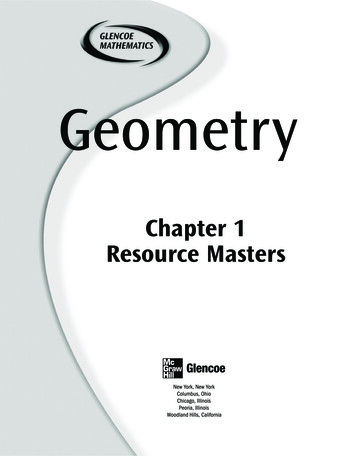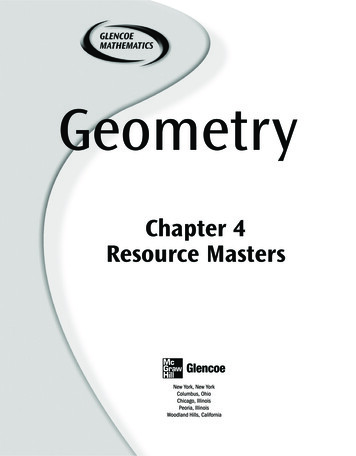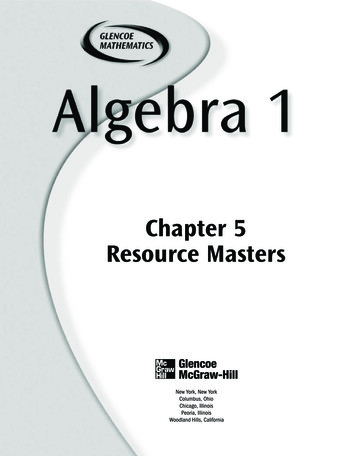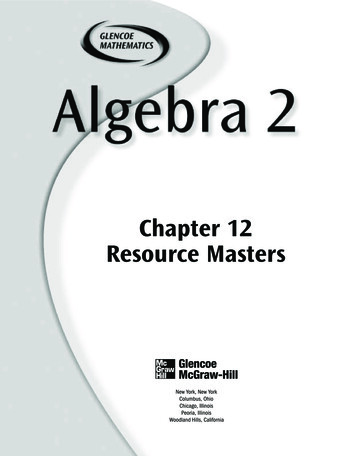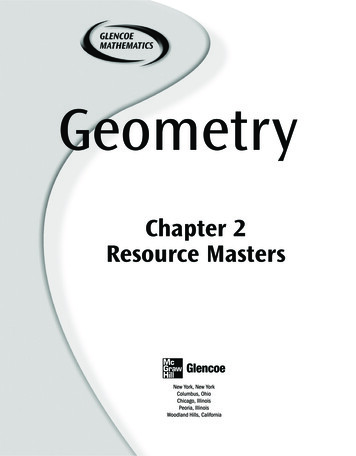
Transcription
GeometryChapter 2Resource Masters
Consumable WorkbooksMany of the worksheets contained in the Chapter Resource Masters bookletsare available as consumable workbooks.Study Guide and Intervention WorkbookSkills Practice WorkbookPractice WorkbookReading to Learn Mathematics 7-861061-3ANSWERS FOR WORKBOOKS The answers for Chapter 2 of these workbookscan be found in the back of this Chapter Resource Masters booklet.Copyright by The McGraw-Hill Companies, Inc. All rights reserved.Printed in the United States of America. Permission is granted to reproduce thematerial contained herein on the condition that such material be reproduced onlyfor classroom use; be provided to students, teachers, and families without charge;and be used solely in conjunction with Glencoe’s Geometry. Any other reproduction,for use or sale, is prohibited without prior written permission of the publisher.Send all inquiries to:The McGraw-Hill Companies8787 Orion PlaceColumbus, OH 43240-4027ISBN: 0-07-860179-71 2 3 4 5 6 7 8 9 10 009 11 10 09 08 07 06 05 04 03GeometryChapter 2 Resource Masters
ContentsVocabulary Builder . . . . . . . . . . . . . . . . viiLesson 2-6Proof Builder . . . . . . . . . . . . . . . . . . . . . . ixStudy Guide and Intervention . . . . . . . . . 87–88Skills Practice . . . . . . . . . . . . . . . . . . . . . . . . 89Practice . . . . . . . . . . . . . . . . . . . . . . . . . . . . 90Reading to Learn Mathematics . . . . . . . . . . . 91Enrichment . . . . . . . . . . . . . . . . . . . . . . . . . . 92Lesson 2-1Study Guide and Intervention . . . . . . . . . 57–58Skills Practice . . . . . . . . . . . . . . . . . . . . . . . . 59Practice . . . . . . . . . . . . . . . . . . . . . . . . . . . . 60Reading to Learn Mathematics . . . . . . . . . . . 61Enrichment . . . . . . . . . . . . . . . . . . . . . . . . . . 62Lesson 2-7Study Guide and Intervention . . . . . . . . . 93–94Skills Practice . . . . . . . . . . . . . . . . . . . . . . . . 95Practice . . . . . . . . . . . . . . . . . . . . . . . . . . . . 96Reading to Learn Mathematics . . . . . . . . . . . 97Enrichment . . . . . . . . . . . . . . . . . . . . . . . . . . 98Lesson 2-2Study Guide and Intervention . . . . . . . . . 63–64Skills Practice . . . . . . . . . . . . . . . . . . . . . . . . 65Practice . . . . . . . . . . . . . . . . . . . . . . . . . . . . 66Reading to Learn Mathematics . . . . . . . . . . . 67Enrichment . . . . . . . . . . . . . . . . . . . . . . . . . . 68Lesson 2-8Study Guide and Intervention . . . . . . . . 99–100Skills Practice . . . . . . . . . . . . . . . . . . . . . . . 101Practice . . . . . . . . . . . . . . . . . . . . . . . . . . . 102Reading to Learn Mathematics . . . . . . . . . . 103Enrichment . . . . . . . . . . . . . . . . . . . . . . . . . 104Lesson 2-3Study Guide and Intervention . . . . . . . . . 69–70Skills Practice . . . . . . . . . . . . . . . . . . . . . . . . 71Practice . . . . . . . . . . . . . . . . . . . . . . . . . . . . 72Reading to Learn Mathematics . . . . . . . . . . . 73Enrichment . . . . . . . . . . . . . . . . . . . . . . . . . . 74Chapter 2 rLesson 2-4Study Guide and Intervention . . . . . . . . . 75–76Skills Practice . . . . . . . . . . . . . . . . . . . . . . . . 77Practice . . . . . . . . . . . . . . . . . . . . . . . . . . . . 78Reading to Learn Mathematics . . . . . . . . . . . 79Enrichment . . . . . . . . . . . . . . . . . . . . . . . . . . 80Lesson 2-5Study Guide and Intervention . . . . . . . . . 81–82Skills Practice . . . . . . . . . . . . . . . . . . . . . . . . 83Practice . . . . . . . . . . . . . . . . . . . . . . . . . . . . 84Reading to Learn Mathematics . . . . . . . . . . . 85Enrichment . . . . . . . . . . . . . . . . . . . . . . . . . . 862 Test, Form 1 . . . . . . . . . . . . 105–1062 Test, Form 2A . . . . . . . . . . . 107–1082 Test, Form 2B . . . . . . . . . . . 109–1102 Test, Form 2C . . . . . . . . . . . 111–1122 Test, Form 2D . . . . . . . . . . . 113–1142 Test, Form 3 . . . . . . . . . . . . 115–1162 Open-Ended Assessment . . . . . . 1172 Vocabulary Test/Review . . . . . . . 1182 Quizzes 1 & 2 . . . . . . . . . . . . . . . 1192 Quizzes 3 & 4 . . . . . . . . . . . . . . . 1202 Mid-Chapter Test . . . . . . . . . . . . 1212 Cumulative Review . . . . . . . . . . . 1222 Standardized Test Practice . 123–124Standardized Test PracticeStudent Recording Sheet . . . . . . . . . . . . . . A1ANSWERS . . . . . . . . . . . . . . . . . . . . . . A2–A35 Glencoe/McGraw-HilliiiGlencoe Geometry
Teacher’s Guide to Using theChapter 2 Resource MastersThe Fast File Chapter Resource system allows you to conveniently file the resourcesyou use most often. The Chapter 2 Resource Masters includes the core materials neededfor Chapter 2. These materials include worksheets, extensions, and assessment options.The answers for these pages appear at the back of this booklet.All of the materials found in this booklet are included for viewing and printing in theGeometry TeacherWorks CD-ROM.Vocabulary BuilderPages vii–viiiinclude a student study tool that presentsup to twenty of the key vocabulary termsfrom the chapter. Students are to recorddefinitions and/or examples for each term.You may suggest that students highlight orstar the terms with which they are notfamiliar.Skills PracticeWHEN TO USE Give these pages toPractice There is one master for eachlesson. These problems more closely followthe structure of the Practice and Applysection of the Student Edition exercises.These exercises are of average difficulty.There is one master foreach lesson. These provide computationalpractice at a basic level.WHEN TO USE These masters can beused with students who have weakermathematics backgrounds or needadditional reinforcement.students before beginning Lesson 2-1.Encourage them to add these pages to theirGeometry Study Notebook. Remind them toadd definitions and examples as theycomplete each lesson.WHEN TO USE These provide additionalpractice options or may be used ashomework for second day teaching of thelesson.Vocabulary BuilderPages ix–xinclude another student study tool thatpresents up to fourteen of the key theoremsand postulates from the chapter. Studentsare to write each theorem or postulate intheir own words, including illustrations ifthey choose to do so. You may suggest thatstudents highlight or star the theorems orpostulates with which they are not familiar.Reading to Learn MathematicsOne master is included for each lesson. Thefirst section of each master asks questionsabout the opening paragraph of the lessonin the Student Edition. Additionalquestions ask students to interpret thecontext of and relationships among termsin the lesson. Finally, students are asked tosummarize what they have learned usingvarious representation techniques.WHEN TO USE Give these pages tostudents before beginning Lesson 2-1.Encourage them to add these pages to theirGeometry Study Notebook. Remind them toupdate it as they complete each lesson.WHEN TO USE This master can be usedas a study tool when presenting the lessonor as an informal reading assessment afterpresenting the lesson. It is also a helpfultool for ELL (English Language Learner)students.Study Guide and InterventionEach lesson in Geometry addresses twoobjectives. There is one Study Guide andIntervention master for each objective.WHEN TO USE Use these masters asreteaching activities for students who needadditional reinforcement. These pages canalso be used in conjunction with the StudentEdition as an instructional tool for studentswho have been absent. Glencoe/McGraw-HillivGlencoe Geometry
A Vocabulary Test, suitable for allstudents, includes a list of the vocabularywords in the chapter and ten questionsassessing students’ knowledge of thoseterms. This can also be used in conjunction with one of the chapter tests or as areview worksheet.EnrichmentThere is one extensionmaster for each lesson. These activities mayextend the concepts in the lesson, offer anhistorical or multicultural look at theconcepts, or widen students’ perspectives onthe mathematics they are learning. Theseare not written exclusively for honorsstudents, but are accessible for use with alllevels of students.Intermediate Assessment Four free-response quizzes are includedto offer assessment at appropriateintervals in the chapter.WHEN TO USE These may be used asextra credit, short-term projects, or asactivities for days when class periods areshortened. A Mid-Chapter Test provides an optionto assess the first half of the chapter. It iscomposed of both multiple-choice andfree-response questions.Assessment OptionsThe assessment masters in the Chapter 2Resources Masters offer a wide range ofassessment tools for intermediate and finalassessment. The following lists describe eachassessment master and its intended use.Continuing Assessment The Cumulative Review providesstudents an opportunity to reinforce andretain skills as they proceed throughtheir study of Geometry. It can also beused as a test. This master includesfree-response questions.Chapter AssessmentCHAPTER TESTS The Standardized Test Practice offerscontinuing review of geometry conceptsin various formats, which may appear onthe standardized tests that they mayencounter. This practice includes multiplechoice, grid-in, and short-responsequestions. Bubble-in and grid-in answersections are provided on the master. Form 1 contains multiple-choice questionsand is intended for use with basic levelstudents. Forms 2A and 2B contain multiple-choicequestions aimed at the average levelstudent. These tests are similar in formatto offer comparable testing situations. Forms 2C and 2D are composed of freeresponse questions aimed at the averagelevel student. These tests are similar informat to offer comparable testingsituations. Grids with axes are providedfor questions assessing graphing skills.Answers Page A1 is an answer sheet for theStandardized Test Practice questionsthat appear in the Student Edition onpages 122–123. This improves students’familiarity with the answer formats theymay encounter in test taking. Form 3 is an advanced level test withfree-response questions. Grids withoutaxes are provided for questions assessinggraphing skills. The answers for the lesson-by-lessonmasters are provided as reduced pageswith answers appearing in red.All of the above tests include a freeresponse Bonus question. Full-size answer keys are provided forthe assessment masters in this booklet. The Open-Ended Assessment includesperformance assessment tasks that aresuitable for all students. A scoring rubricis included for evaluation guidelines.Sample answers are provided forassessment. Glencoe/McGraw-HillvGlencoe Geometry
NAME DATE2PERIODReading to Learn MathematicsThis is an alphabetical list of the key vocabulary terms you will learn in Chapter 2.As you study the chapter, complete each term’s definition or description. Rememberto add the page number where you found the term. Add these pages to yourGeometry Study Notebook to review vocabulary at the end of the chapter.Vocabulary TermFoundon PageDefinition/Description/Examplebiconditional conversecounterexampledeductive reasoningdisjunctionif-then statement(continued on the next page) Glencoe/McGraw-HillviiGlencoe GeometryVocabulary BuilderVocabulary Builder
NAME DATE2PERIODReading to Learn MathematicsVocabulary BuilderVocabulary Term(continued)Foundon PageDefinition/Description/Exampleinductive reasoninginversenegationparagraph proofpostulatestatementtheoremtruth tabletruth valuetwo-column proof Glencoe/McGraw-HillviiiGlencoe Geometry
NAME DATE2PERIODLearning to Read MathematicsThis is a list of key theorems and postulates you will learn in Chapter 2. As youstudy the chapter, write each theorem or postulate in your own words. Includeillustrations as appropriate. Remember to include the page number where youfound the theorem or postulate. Add this page to your Geometry Study Notebookso you can review the theorems and postulates at the end of the chapter.Theorem or PostulateFoundon PageDescription/Illustration/AbbreviationTheorem 2.1Midpoint TheoremTheorem 2.2Theorem 2.3Supplement TheoremTheorem 2.4Complement TheoremTheorem 2.5Theorem 2.6Theorem 2.7(continued on the next page) Glencoe/McGraw-HillixGlencoe GeometryProof BuilderProof Builder
NAME DATE2PERIODLearning to Read MathematicsProof BuilderTheorem or Postulate(continued)Foundon PageDescription/Illustration/AbbreviationTheorem 2.8Vertical Angle TheoremTheorem 2.9Theorem 2.10Theorem 2.11Theorem 2.12Theorem 2.13Postulate 2.9Segment Addition Postulate Glencoe/McGraw-HillxGlencoe Geometry
NAME DATE2-1PERIODStudy Guide and InterventionInductive Reasoning and ConjectureMake Conjectures A conjecture is a guess based on analyzing information orobserving a pattern. Making a conjecture after looking at several situations is calledinductive reasoning.Example 2Make a conjecture aboutthe next number in the sequence 1, 3, 9,27, 81.Analyze the numbers:Notice that each number is a power of 3.139 27 8130 31 32 33 34Conjecture: The next number will be 35 or 243.Makea conjecture aboutthe number of smallsquares in the next figure.Observe a pattern: The sides of the squareshave measures 1, 2, and 3 units.Conjecture: For the next figure, the side ofthe square will be 4 units, so the figurewill have 16 small squares.ExercisesDescribe the pattern. Then make a conjecture about the next number in thesequence.1. 5, 10, 20, 402. 1, 10, 100, 10006 7 85 5 53. 1, , , Make a conjecture based on the given information. Draw a figure to illustrateyour conjecture.4. A( 1, 1), B(2, 2), C(4, 4)5. 1 and 2 form a right angle.PC (4, 4)B(2, 2)16. ABC and DBE are vertical angles.BCEDGlencoe/McGraw-HillW7. E and F are right angles.T 2TA(–1, –1)AR57PQEFRGlencoe GeometryLesson 2-1Example 1
NAME DATE2-1PERIODStudy Guide and Intervention(continued)Inductive Reasoning and ConjectureFind Counterexamples A conjecture is false if there is even one situation in which theconjecture is not true. The false example is called a counterexample.ExampleDetermine whether the conjecture is true or false.If it is false, give a counterexample.Given: A B B C Conjecture: B is the midpoint of A C .Is it possible to draw a diagram with A B B C such that B isnot the midpoint? This diagram is a counterexample becausepoint B is not on A C . The conjecture is false.AC3 cm3 cmBExercisesDetermine whether each conjecture is true or false. Give a counterexample forany false conjecture.1. Given: Points A, B, and C are collinear.Conjecture: AB BC AC2. Given: R and S are supplementary. R and T are supplementary.Conjecture: T and S are congruent.BAC3. Given: ABC and DEF aresupplementary.Conjecture: ABC and DEF forma linear pair.CA B4. Given: D E E F Conjecture: DEF is a right angle.DEGlencoe/McGraw-HillF58Glencoe Geometry
NAME DATE2-1PERIODSkills PracticeInductive Reasoning and ConjectureMake a conjecture about the next item in each sequence.1.924. 2, 4, 8, 16, 323. 6, , 5, , 4Make a conjecture based on the given information. Draw a figure to illustrateyour conjecture.6. Point P is the midpoint of N Q .5. Points A, B, and C are collinear,and D is between B and C.AC DBN7. 1, 2, 3, and 4 form fourlinear pairs.13PQ8. 3 42344Determine whether each conjecture is true or false. Give a counterexample forany false conjecture.9. Given: ABC and CBD form a linear pair.Conjecture: ABC CBD10. Given: A B , B C , and A C are congruent.Conjecture: A, B, and C are collinear.11. Given: AB BC ACConjecture: AB BCABC12. Given: 1 is complementary to 2, and 1 is complementary to 3.Conjecture: 2 3 Glencoe/McGraw-Hill59Glencoe GeometryLesson 2-11122. 4, 1, 2, 5, 8
NAME DATE2-1PERIODPracticeInductive Reasoning and ConjectureMake a conjecture about the next item in each sequence.1.2. 5, 10, 15, 201 12 4183. 2, 1, , , 4. 12, 6, 3, 1.5, 0.75Make a conjecture based on the given information. Draw a figure to illustrateyour conjecture.5. ABC is a right angle.6. Point S is between R and T.RABSTC7. P, Q, R, and S are noncollinearand P Q Q R R S S P .PQSR8. ABCD is a parallelogram.ADBCDetermine whether each conjecture is true or false. Give a counterexample forany false conjecture.9. Given: S, T, and U are collinear and ST TU.Conjecture: T is the midpoint of S U .10. Given: 1 and 2 are adjacent angles.Conjecture: 1 and 2 form a linear pair.11. Given: G H and J K form a right angle and intersect at P.Conjecture: G H J K 12. ALLERGIES Each spring, Rachel starts sneezing when the pear trees on her street blossom.She reasons that she is allergic to pear trees. Find a counterexample to Rachel’s conjecture. Glencoe/McGraw-Hill60Glencoe Geometry
NAME DATE2-1PERIODReading to Learn MathematicsInductive Reasoning and ConjecturePre-ActivityHow can inductive reasoning help predict weather conditions?Read the introduction to Lesson 2-1 at the top of page 62 in your textbook. What is a factor that might contribute to long-term changes in theweather?Reading the Lesson1. Explain in your own words the relationship between a conjecture, a counterexample, andinductive reasoning.2. Make a conjecture about the next item in each sequence.1 1 13 9 27a. 5, 9, 13, 17b. 1, , , c. 0, 1, 3, 6, 10e. 1, 8, 27, 64g.d. 8, 3, 2, 7f. 1, 2, 4, 8h.3. State whether each conjecture is true or false. If the conjecture is false, give acounterexample.a. The sum of two odd integers is even.b. The product of an odd integer and an even integer is odd.c. The opposite of an integer is a negative integer.d. The perfect squares (squares of whole numbers) alternate between odd and even.Helping You Remember4. Write a short sentence that can help you remember why it only takes one counterexampleto prove that a conjecture is false. Glencoe/McGraw-Hill61Glencoe GeometryLesson 2-1 What kind of weather patterns do you think meteorologists look at tohelp predict the weather?
NAME DATE2-1PERIODEnrichmentCounterexamplesWhen you make a conclusion after examining several specificcases, you have used inductive reasoning. However, you must becautious when using this form of reasoning. By finding only onecounterexample, you disprove the conclusion.Example1xIs the statement 1 true when you replace x with1, 2, and 3? Is the statement true for all reals? If possible, find acounterexample.11111 1, 1, and 1. But when x , then 2. This counterexample1232xshows that the statement is not always true.Answer each question. 1. The coldest day of the year in Chicagooccurred in January for five straightyears. Is it safe to conclude that thecoldest day in Chicago is always inJanuary?2. Suppose John misses the school busfour Tuesdays in a row. Can yousafely conclude that John misses theschool bus every Tuesday?3. Is the equation k2 k true when youreplace k with 1, 2, and 3? Is theequation true for all integers? Ifpossible, find a counterexample.4. Is the statement 2x x x true when1you replace x with , 4, and 0.7? Is the2statement true for all real numbers?If possible, find a counterexample.5. Suppose you draw four points A, B, C,and D and then draw A B , B C , C D , andD A . Does this procedure give aquadrilateral always or only sometimes?Explain your answers with figures.6. Suppose you draw a circle, mark threepoints on it, and connect them. Will theangles of the triangle be acute? Explainyour answers with figures.Glencoe/McGraw-Hill62Glencoe Geometry
NAME DATE2-2PERIODStudy Guide and InterventionLogicDetermine Truth Values A statement is any sentence that is either true or false. Thetruth or falsity of a statement is its truth value. A statement can be represented by using aletter. For example,Statement p: Chicago is a city in Illinois. The truth value of statement p is true.Several statements can be joined in a compound statement.Statement p and statement q joinedby the word and is a conjunction.Statement p and statement q joinedby the word or is a disjunction.Negation: not p is the negation ofthe statement p.Symbols: p q (Read: p and q)Symbols: p q (Read: p or q)Symbols: p (Read: not p)The conjunction p q is true onlywhen both p and q are true.The disjunction p q is true if p istrue, if q is true, or if both are true.The statements p and p haveopposite truth values.Example 2Write a compoundstatement for each conjunction. Thenfind its truth value.p: An elephant is a mammal.q: A square has four right angles.Write a compoundstatement for each disjunction. Thenfind its truth value.p: A diameter of a circle is twice the radius.q: A rectangle has four equal sides.a. p qJoin the statements with and: An elephantis a mammal and a square has four rightangles. Both parts of the statement aretrue so the compound statement is true.a. p qJoin the statements p and q with theword or: A diameter of a circle is twicethe radius or a rectangle has four equalsides. The first part of the compoundstatement, p, is true, so the compoundstatement is true.b. p q p is the statement “An elephant is not amammal.” Join p and q with the wordand: An elephant is not a mammal and asquare has four right angles. The firstpart of the compound statement, p, isfalse. Therefore the compound statementis false.b. p qJoin p and q with the word or: Adiameter of a circle is not twice theradius or a rectangle has four equalsides. Neither part of the disjunction istrue, so the compound statement is false.ExercisesWrite a compound statement for each conjunction and disjunction.Then find its truth value.p: 10 8 18q: September has 30 days. r: A rectangle has four sides.1. p and q.2. p or r3. q or r4. q and r Glencoe/McGraw-Hill63Glencoe GeometryLesson 2-2Example 1
NAME DATE2-2PERIODStudy Guide and Intervention(continued)LogicTruth Tables One way to organizethe truth values of statements is in atruth table. The truth tables fornegation, conjunction, and disjunctionare shown at the right.Example 1Construct a truthtable for the compoundstatement q or r. Use thedisjunction table.NegationDisjunctionConjunctionp ppqp qpqp qTFFTTTFFTFTFTFFFTTFFTFTFTTTFExample 2Construct a truth table for thecompound statement p and (q or r).Use the disjunction table for (q or r). Then use theconjunction table for p and (q or r).qrq or rpqrTTFFTFTFTTTFTTTTFFFFTTFFTTFFTFTFTFTFq or r p and (q or r)TTTFTTTFTTTFFFFFExercisesContruct a truth table for each compound statement.1. p or r4. p r Glencoe/McGraw-Hill2. p q3. q r5. ( p and r) or q64Glencoe Geometry
NAME DATE2-2PERIODSkills PracticeLogicUse the following statements to write a compound statement for each conjunctionand disjunction. Then find its truth value.p: 3 2 5q: Vertical angles are congruent.r: 2 8 10s: The sum of the measures of complementary angles is 90 .1. p and q2. p r3. p or sLesson 2-24. r s5. p q6. q rCopy and complete each truth table.7.q qTTTFTFTFTFTFTFFFFFTqT p p q ( p q)8.ppp qConstruct a truth table for each compound statement.9. q r Glencoe/McGraw-Hill10. p r65Glencoe Geometry
NAME DATE2-2PERIODPracticeLogicUse the following statements to write a compound statement for each conjunctionand disjunction. Then find its truth value.p: 60 seconds 1 minuteq: Congruent supplementary angles each have a measure of 90.r: 12 11 11. p q2. q r3. p q4. p rCopy and complete each truth table.5.pqT p q p q6.pqTTTTFTFFTFTFFFF p p qp ( p q)Construct a truth table for each compound statement.7. q (p q)8. q ( p q)SCHOOL For Exercises 9 and 10, use the followinginformation.The Venn diagram shows the number of students in the bandwho work after school or on the weekends.WorkAfterSchool53WorkWeekends179. How many students work after school and on weekends?10. How many students work after school or on weekends? Glencoe/McGraw-Hill66Glencoe Geometry
NAME DATE2-2PERIODReading to Learn MathematicsLogicPre-ActivityHow does logic apply to school?Read the introduction to Lesson 2-2 at the top of page 67 in your textbook.How can you use logic to help you answer a multiple-choice question on astandardized test if you are not sure of the correct answer?1. Supply one or two words to complete each sentence.a. Two or more statements can be joined to form astatement.b. A statement that is formed by joining two statements with the word or is called a.c. The truth or falsity of a statement is called its.d. A statement that is formed by joining two statements with the word and is called a.e. A statement that has the opposite truth value and the opposite meaning from a givenstatement is called theof the statement.2. Use true or false to complete each sentence.a. If a statement is true, then its negation is.b. If a statement is false, then its negation is.c. If two statements are both true, then their conjunction istheir disjunction is.d. If two statements are both false, then their conjunction istheir disjunction is.e. If one statement is true and another is false, then their conjunction isand their disjunction is.andand3. Consider the following statements:p: Chicago is the capital of Illinois. q: Sacramento is the capital of California.Write each statement symbolically and then find its truth value.a. Sacramento is not the capital of California.b. Sacramento is the capital of California and Chicago is not the capital of Illinois.Helping You Remember4. Prefixes can often help you to remember the meaning of words or to distinguish betweensimilar words. Use your dictionary to find the meanings of the prefixes con and dis andexplain how these meanings can help you remember the difference between aconjunction and a disjunction. Glencoe/McGraw-Hill67Glencoe GeometryLesson 2-2Reading the Lesson
NAME DATE2-2PERIODEnrichmentLetter PuzzlesAn alphametic is a computation puzzle using letters instead ofdigits. Each letter represents one of the digits 0–9, and twodifferent letters cannot represent the same digit. Some alphameticpuzzles have more than one answer.ExampleSolve the alphametic puzzle at the right.FOUR ONE F I VESince R E E, the value of R must be 0. Notice that thethousands digit must be the same in the first addend and thesum. Since the value of I is 9 or less, O must be 4 or less. Usetrial and error to find values that work.F 8, O 3, U 1, R 08310 347 8657N 4, E 7, I 6, and V 5.Can you find other solutions to this puzzle?Find a value for each letter in each alphametic.1.HALF HALF WHOLE2.TWO TWO FOURH A L T W O F W O F U R E 3.THREETHREE ONE SEVEN4.SEND MORE MONEYT H R S E N E O N D M O S V R Y 5. Do research to find more alphametic puzzles, or create your own puzzles. Challengeanother student to solve them. Glencoe/McGraw-Hill68Glencoe Geometry
NAME DATE2-3PERIODStudy Guide and InterventionConditional StatementsIf-then StatementsAn if-then statement is a statement such as “If you are readingthis page, then you are studying math.” A statement that can be written in if-then form iscalled a conditional statement. The phrase immediately following the word if is thehypothesis. The phrase immediately following the word then is the conclusion.A conditional statement can be represented in symbols as p q, which is read “p implies q”or “if p, then q.”Example 1Identify the hypothesis and conclusion of the statement.If X R and R S, then X S.hypothesisconclusionExample 2Identify the hypothesis and conclusion.Write the statement in if-then form.You receive a free pizza with 12 coupons.If you have 12 coupons, then you receive a free pizza.hypothesisconclusionExercisesIdentify the hypothesis and conclusion of each statement.1. If it is Saturday, then there is no school.Lesson 2-32. If x 8 32, then x 40.3. If a polygon has four right angles, then the polygon is a rectangle.Write each statement in if-then form.4. All apes love bananas.5. The sum of the measures of complementary angles is 90.6. Collinear points lie on the same line.Determine the truth value of the following statement for each set of conditions.If it does not rain this Saturday, we will have a picnic.7. It rains this Saturday, and we have a picnic.8. It rains this Saturday, and we don’t have a picnic.9. It doesn’t rain this Saturday, and we have a picnic.10. It doesn’t rain this Saturday, and we don’t have a picnic. Glencoe/McGraw-Hill69Glencoe Geometry
NAME DATE2-3PERIODStudy Guide and Intervention(continued)Conditional StatementsConverse, Inverse, and Contrapositive If you change the hypothesis or conclusionof a conditional statement, you form a related conditional. This chart shows the threerelated conditionals, converse, inverse, and contrapositive, and how they are related to aconditional statement.SymbolsFormed byExampleConditionalp qusing the given hypothesis and conclusionIf two angles are vertical angles,then they are congruent.Converseq pexchanging the hypothesis and conclusionIf two angles are congruent, thenthey are vertical
Glencoe/McGraw-Hill iv Glencoe Geometry Teacher’s Guide to Using the Chapter 2 Resource Masters The Fast FileChapter Resource system allows you to conveniently file the resources you use most often. The Chapter 2 Resource Mastersincludes the core materials needed for Chapter 2. These material




